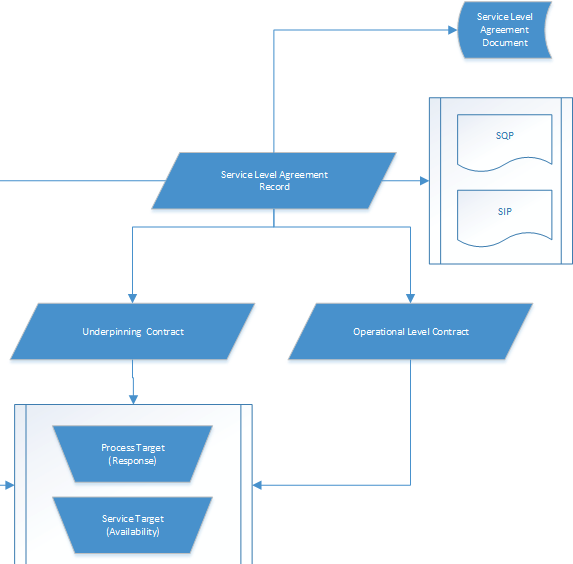
IT Service Level Agreement (Image by SLA)

IT Service Level Agreement (Image by SLA)
An IT Service Level Agreement (SLA) is a contract between an IT service provider and its customer.
The core of an SLA is to set clear expectations and standards for the quality and availability of IT services.
It’s like a promise the IT team makes to its customers, detailing what services they’ll provide and how well they’ll do it.
But why are SLAs so crucial? Well, reliable IT is the backbone of any business. When systems hum along, productivity soars, customers groove, and profits jive.
Conversely, IT hiccups can throw the whole rhythm off, leading to lost revenue, frustrated employees, and a chorus of complaints.
For example, you can see how Microsoft has a dedicated page just dedicated to Service Level Agreements (SLA) for online services.
It shows Microsoft transparency and commitment from the beginning. In other words, Microsoft systems are always available. This leads to higher productivity and customer satisfaction.
So, let’s get into the details of why and how SLAs become a fundamental part of your IT business dealings.
When we talk about an IT Service Level Agreement (SLA), we’re essentially discussing a roadmap for success in IT services.
The beauty of an SLA lies in its ability to set clear expectations. SLA spells out precisely what services will be provided and the standard they should meet.
This clarity is crucial because, let’s face it, nobody likes surprises when it comes to IT support.
Now, consider the aspect of reliability. An SLA is like a pledge from the IT provider to keep things running smoothly. For a business, this means fewer headaches and more consistent operations.
But it’s not just about setting expectations; it’s also about building trust. An SLA creates a sense of accountability. It’s a way of saying, “We promise to deliver this, and you can hold us to that promise.”
This trust is key in any business relationship, especially when it comes to something as integral as IT.
Then there’s the part about measuring performance. An SLA isn’t just a set-it-and-forget-it deal.
SLA offers a way to continuously evaluate how well the IT services are doing. If something’s not up to the mark, the SLA serves as a starting point for making improvements.
And let’s not forget growth and scalability. With a solid SLA in place, businesses can plan their growth more confidently.
They know their IT infrastructure can handle it, which is a big deal in today’s fast-paced business world.
Last but not least, an SLA can be a lifesaver when it comes to legal protection and risk management.
SLA outlines what happens if things don’t go as planned, providing a safety net for businesses against IT mishaps. In addition to this, we have also prepared a comprehensive explanation of IT Service Delivery. Read the article “IT Service Delivery: Definition & Steps” if you would like to delve deeper into it.
Different situations require different approaches, especially when it comes to Service Level Agreements (SLAs).
To find the ideal match for your business, it’s helpful to understand the three primary types of SLAs available.
Let’s take a closer look at each to see which one best suits your needs.
A customer-based SLA is designed for individual customers. Here, the focus is on the specific needs and requirements of a single customer.
This type of SLA details the services that a particular customer will receive and the standards they can expect.
It’s pretty useful when a service provider has a varied range of services and the client picks a unique mix suited to their needs.
Let’s say your business has various departments, each with its own IT demands. This SLA adapts to those needs, providing specific services, uptime guarantees, and support for each one.
For companies with multiple customer types or diverse internal teams, this SLA solution is a fantastic fit.
What makes it great? Well, it’s the personalized touch. Everyone gets exactly the IT support they need, nothing more, nothing less.
It’s flexible enough to cater to different service levels and it’s particularly useful for organizations that have a wide spectrum of IT needs. In short, it ensures that every part of your business gets the IT attention it deserves.
However, the challenge lies in managing multiple, diverse SLAs for different customers, which can be complex and time-consuming.
In a service-based SLA, the agreement is standardized for all customers who use a particular service. Imagine a one-size-fits-all approach, but in a good way.
Service-based simplifies the SLA process as the same terms apply to all customers who opt for that service.
This type is common in scenarios where a service provider offers a specific service that is uniform for all clients, like web hosting, cloud services, or email and online transactions.
Say you rely heavily on email and online transactions. A service-based SLA would define uptime, response times, and recovery guarantees for those specific systems, ensuring they hum along no matter what.
The advantage here is the uniformity and consistency it offers, making it easier for both the provider and the customers to understand and manage expectations.
However, the drawback is the lack of customization, which might not suit clients with unique needs.
A multi-Level SLA is a bit more complex. It layers multiple SLAs, often dividing them into different levels.
Multi-Level SLA is perfect for large organizations with varying IT needs across different departments.
This type is structured to address different aspects of the IT services. For example, there could be a tier dealing with corporate-level agreements, another for customer-level service, and yet another for specific services.
It’s like a hierarchy of agreements, each focusing on different aspects of the service provider’s relationship with the customer. The major benefit is the flexibility and comprehensive coverage it offers.
It allows addressing broad issues at the corporate level while also catering to specific needs at the customer or service level.
At the base, you have universal guarantees for everyone. Then, each level up might offer tighter performance parameters, faster support response, or dedicated resources for specific teams.
The challenge, however, is in maintaining clarity and avoiding conflicts between the different levels of SLAs.

The difference between an IT Service Level Agreement (SLA) and a Key Performance Indicator (KPI) is like the relationship between a promise and a progress report in the IT business.
An IT SLA is essentially a contract between an IT service provider and a client. It outlines the scope of services, the quality, and the standards to which these services will be provided.
SLA is a comprehensive document that details what the client can expect in terms of IT support, availability, response times, and other service-specific aspects.
On the other hand, a KPI is a metric used to evaluate the effectiveness and success of an IT service.
These are quantifiable measurements, like the percentage of uptime, average resolution time for IT issues, or customer satisfaction rates.
KPIs are used to track progress, measure performance, and determine whether the services are meeting the agreed-upon standards in the SLA.
Just as the SLA sets the stage for expected IT service standards, KPIs are the tools that measure how well those standards are being met.
To ensure a smooth and successful IT relationship, a well-crafted SLA has several components.
You can ensure that your IT provider delivers the performance you need to succeed by understanding these key components.
At the heart of it is the scope of services. This part is crucial as it clearly lays out the range of services you’ll receive, covering everything from routine network maintenance to specialized software support.
Then we delve into service levels for a clear expectation of service quality. Here’s where you set clear benchmarks for IT service performance.
This step includes specifics like how quickly the IT team responds to issues, how long it takes to resolve them, and uptime guarantees.
Having a guide for smoothly handling IT challenges is followed by communication and escalation.
This phase is about having a plan for when things don’t go as expected. This includes established channels for reporting problems and a clear pathway for escalating unresolved issues.
Then, monitoring and reporting is like getting consistent progress reports on your IT services.
This step involves tracking how well the IT services are meeting the set standards and regularly updating you on the performance.
Security and compliance are non-negotiable when it comes to ensuring your IT environment is secure and compliant.
This part ensures that all the necessary security measures are in place, data privacy is maintained, and everything is in line with relevant regulations.
Remedies and penalties address the reality that sometimes things don’t go as planned. It outlines the actions to be taken if service levels falter, from compensations to penalties.
Lastly, review and revision keep your SLA current. As your business evolves, so should your SLA, ensuring it remains effective and relevant.
Writing an IT service level agreement (SLA) is like setting the rules for a win-win game. Here are some best practices to ensure your SLA hits the mark.
Start by clearly defining your IT needs. Yes, you need to know what services are vital and which performance levels are essential.
This approach helps keep your SLA focused on your key objectives.
Then, involve your IT provider in the SLA creation process. They’re not just fulfilling a service; they’re your strategic partners.
Their input is invaluable in setting realistic goals and foreseeing potential challenges.
That’s why clarity is critical to your relationship. Your SLA should be written in plain language. It’s a mutual agreement, not a complex code to decipher.
Moreover, choose specific, measurable performance metrics like uptime and response times.
These tangible benchmarks are key to tracking progress and maintaining accountability.
So, you must recognize that different services have different priorities. Consider having tiered SLAs to address various needs efficiently and cost-effectively.
This is why you need effective communication as the engine of any successful IT partnership.
Make sure you establish clear channels for regular updates and escalation processes.
And, don’t forget regular reviews of your SLA. Your business and IT landscape will evolve, so your SLA should too. This flexibility keeps the agreement relevant and effective.
Don’t shy away from including penalties for missed targets. Fair consequences encourage adherence to the SLA and keep everyone focused.
Lastly, celebrate your IT achievements. Recognizing successes fosters a positive and collaborative relationship, fueling long-term success.
In our exploration of IT Service Level Agreements (SLAs), we’ve seen how essential they are to a successful IT partnership.
An SLA isn’t just a formality; it’s a strategic tool that sets clear expectations, ensures accountability, and fosters trust between IT service providers and customers.
If you’re looking to strengthen your company’s IT foundation, investing in a well-structured SLA and adhering to best practices is a smart move.
It’s about building a solid IT partnership that supports and grows with your business.
Why not take the next step? Review your current SLA or start creating one specifically tailored to your company’s needs.
It’s a proactive step toward improving your IT services and ensuring they are perfectly aligned with your business goals. Remember, a solid IT partnership starts with a well-defined SLA.